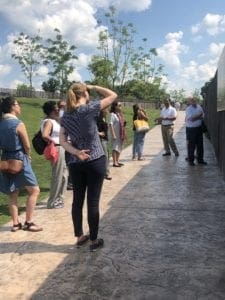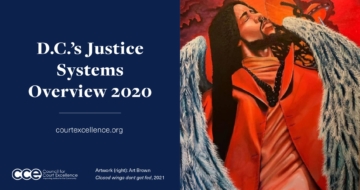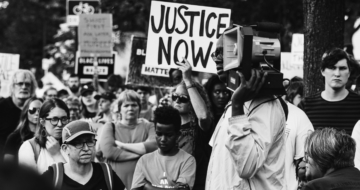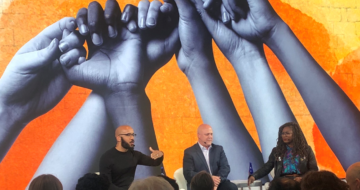
This May, Public Welfare Foundation’s board and staff convened in Montgomery, Alabama for its Spring board meeting.
The goal of the time together was not only to advance Public Welfare’s new strategic framework focused on criminal and youth justice, but also to experience the National Memorial for Peace and Justice and The Legacy Museum as a team. At Public Welfare, we believe we must acknowledge our country’s history of racial terror to move forward from it.

Together, we bore witness to the 4400+ black men, women and children that were hanged, burned, shot and beaten by white mobs from 1877 – 1950. As an early supporter of Equal Justice Initiative, it was an honor for us to visit both sites and spend time with Executive Director Bryan Stevenson discussing ways to advance our collective mission of transformative justice.
The following are select reflections from our team as they look back on our recent trip to Montgomery.
Sarah Joy Albrecht, Program Analyst:
“Visiting Montgomery left me with a much sharper understanding of what happened there and why, regarding civil rights and racial justice, and the imperative of our ongoing work. The statutes and historical markers throughout downtown indicate that this is a place and a culture that likes to commemorate things – making the omission of slavery and racial violence especially blatant, and Bryan Stevenson’s work to acknowledge and situate that history especially important. In addition to the National Memorial for Peace and Justice, Montgomery now includes historical markers to commemorate the sites of Slave Depots and the Domestic Slave Trade, thanks to the Equal Justice Initiative. Also in this mix stands the church where Dr. Martin Luther King first ministered the gospel of human rights and helped launch a non-violent direct action campaign against the campaign of direct and publicly-sanctioned violence toward African Americans.
There remains a strategic imperative to confront racial terror with direct action and policy change, one that drives Public Welfare Foundation in advancing transformative justice, as we aim to support and uphold the unyielding work of human rights fighters who dare to rise up for dignity and change.”
Colin Diver, Board of Director:

“Visiting the National Memorial and Legacy Museum was the most meaningful experience of my time as a Public Welfare Foundation director, and the most powerful affirmation of the importance of the Foundation’s work.
If you have any doubt about the direct link between slavery and mass incarceration, spend an hour walking through a veritable hanging forest of lynching memorials, viewing photographs of prison chain gangs, and listening to the voices of imprisoned black men. It will change your life, and impel you to do everything in your power to restore justice to our justice system.”
Robert Shull, Program Director for Workers’ Rights:
“One of many takeaways from our trip to Montgomery: cities can do well by doing good. For years, we’ve seen excellent groups such as the Los Angeles Alliance for a New Economy and their sister groups in the Partnership for Working Families lead cities to rethink economic development: not as an area of expertise that’s exclusive to developers and planning boards but as an opportunity to leverage public investment to meet public needs, such as safe, family-sustaining jobs.
EJI is writing a whole new chapter for that story with the National Memorial and Legacy Museum. Our country needs these institutions to preserve and express the memory of a painful time. Now that Montgomery is home to the memorial and museum, people from all over the country are making their journey to engage with that living memory – and they’re filling up the city’s hotels, eating in their restaurants, and bringing a much-needed jolt to the city’s fortunes.
Development doesn’t just have to mean contractor profits, and remembrance isn’t just mere charity. Sometimes, what’s vital to our cultural life can add vitality to local economies as well.”
Phillipa Taylor, Chief Financial and Administrative Officer:
The most impactful takeaway from visiting the Memorial and Museum in Montgomery is the clear connection between capitalism and slavery/Jim Crow. Those who own capital will focus on the bottom line and will seek the materials and labor to generate that profit at the lowest possible cost. If one does not value or see that labor source as human, the treatment of them as a commodity comes all too easily. Where slavery once served this purpose, our prison systems provide an unending source of such labor, and corporations continue to benefit.
Kim Taylor-Thompson, Board of Director:
“My greatest takeaway from visiting the Legacy Museum and the National Memorial for Peace and Justice was this: we owe it to those who sacrificed their lives to continue the fight against racial terror in all its forms. As I walked through both the museum and memorial, I had not expected to be so deeply moved … again. I had visited both a year earlier when they opened and had found the experience heart-wrenching, raw and transformative. My recent visit with the Board and staff of Public Welfare Foundation was equally emotional but, in their company, I found the strength to slow down, see more, and absorb more than I had my first time. I again saw the names of thousands who had been lynched, but this time I noticed one marker listing an entire family – parents and children. How can you see that evidence of raw brutality and not be changed? Maya Angelou reminds us, ‘History, despite its wrenching pain, cannot be unlived, but if faced with courage need not be faced again.’ That is how we get to the other side. The ideology that sanctioned ‘disciplining’ the Black community with lynchings and random violence has not dissipated over time. It has simply been updated and is now enjoying a resurgence. We have much work to do.”







